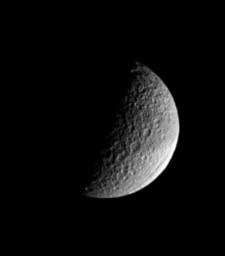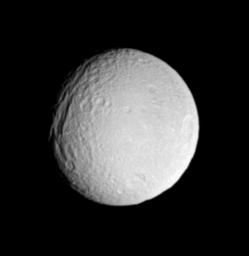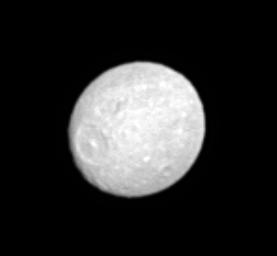Friday, July 08, 2005
The website for the ISS instrument on Cassini has been upgraded with a few new enhancements. The first is a new search feature which makes it easier to find the image you are looking for. The other is the addition of flash on certain parts of the site, like the imaging diary page. These upgrades make it easier to navigate the page, particularly as the amount of data and images on the site increases substantially over the coming months and years.
Titan Rev11 Observations

I have to admit this set caught me by surprise, but there is now a full sequence of Titan images on the JPL Raw images page taken yesterday. These images were taken from a distance of 1.25 million km and have a resolution of 7.25 km/pixel. The CB3 images in the sequence, like the one above, show the western boundary of the continent-sized bright region known as Xanadu. The dark terrain to the west contains numerous bright features, often called "islands" by Cassini scientists, though there is no evidence that the dark terrain that surrounds them is liquid, in fact it is probably nothing more than a sand dune "sea". The Huygens landing site is just coming into view near the center of the terminator. This region was seen at much higher resolution during the Ta, Tb, and T3 flybys by Cassini and will be seen next during the T8 flyby in October. In the other filters, note the assymmetry in brightness between the northern and southern hemispheres in the MT3 filter image.
Thursday, July 07, 2005
Tethys Geography Lesson using a new raw image
The Cassini Raw images page has a new raw image of Tethys taken from a distance of 2,581,702 km, yielding a resolution of 15 km/pixel. While low resolution, you can see a number of very large craters on Tethys' trailing hemisphere. At three o'clock, you can see Penelope. Near the center of the disk, you can see three craters, from north to south: Phemius, Polyphemus, and Ajax. Near 6 o'clock, you can see a crater that's a little smaller than Penelope named Antinous. The small crater near the terminator left of the three, north-south craters is called Arete.
Wednesday, July 06, 2005
New Tethys Image: Tethys Mysteries

Today's image of the day from CICLOPS is another view of Tethys, this time a crescent view from May 22, a couple of days after yesterday's daily release image. This view shows the region between Ithaca Chasma and Odysseus impact basin. Ithaca Chasma can be seen near the limb near 4 o'clock. The heavily crater region (the two large craters near the terminator at center are Mentor at north and Circe at south) also boasts a dark stripe that runs from Ithaca Chasma back to Odysseus. The exact nature of this stripe is currently unknown, though frequent reader Phil Stooke has proposed that the stripe is a cryoclastic deposit from geysers along Ithaca Chasma.
Tuesday, July 05, 2005
New Tethys Image: Icy Scars

CICLOPS has released this processed view of Tethys taken in late May. In this view you can see Ithaca Chasma along the terminator at left. Just to the southeast of Ithaca (north is up), you can see a very old, degraded impact basin which has since been modified by later impact events. Throughout this view of Tethys, you can see numerous impact scars, including Penelope near the bright limb at the 3 o'clock position.
This image has a resolution of 6 km/pixel (magnified 2x for feature visibility) and was taken on May 20.
Monday, July 04, 2005
Off-Topic: Deep Impact

What an exciting 24 hours. I know this doesn't have anything to do with outer planetary satellites, but I still found this fascinating enough to post here. You can comment if you like here. All Deep Impact-related discussion by myself or you, the reader, will be limited to this post.
For the most, comets have not interested me. Sure, I looked for Hale-Bopp, but that was pretty much the limit of my interest. Stardust and Deep Space 1 didn't really help much. The images they returned were lackluster at best, at least the ones released to the public. Being more of a geologist at heart, such images hold little interest to me. Enter Deep Impact.
The images this mission has returned have been spectacular. Even small thumbnails circulating on the web are spectacular, showing the impact event as well as the impact region before the event. The latter has been holding my interest the most (sure I like that "flash" image from HRI, but that only holds my attention for so long). The pre-impact impactor images are fascinating, showing wonderful detail of the comet's surface at up to 7 m/pixel. The above image shows the region a minute or so before impact. You can see circular features as well as a number of "north"-ward facing scarps. I should point out that all directional phrases I use assume north is up, which has no basis in reality, I'm just using it till I hear otherwise. Anyways, the circular features obviously look like craters, at least that would be the initial interpretation, but look closely. Sunlight is coming from lower right. The circular features are surrounded by dark "stuff" that has a sharp inner contact and a diffuse outer one. This shading, I posit, is more suggestive of an outward facing scarp rather an inward facing crater rim.
So what do we make of this morphology? Combine this with some earlier impactor images and the bright markings you see in the above image, and you start to see the full picture. I suspect we are looking at cliffs that are being eroded away by cometary outgassing. The jets remove surface layer material (water ice, which volatilizes, and "other" material) and eject it into space. Over time, you go from the circular pits seen by Stardust at Wild 2, to the terraced formations we see here at an older, more evolved comet like Tempel 1. The lack of craters on the surface (the artificial one notwithstanding) can explained by saying that the rate of resurfacing (or the removal of surface) is faster than the rate of impacts.
Now to the impact itself. We saw quite a bright flash :o So what explains that? First, the HRI images appear to show low angle ejecta with radial structure. Perhaps we are seeing the formation of rays? Surprising considering the size of the nucleus. The impact kicked up a considerable amount of material that didn't return. Maybe the impact created a new jet as it exposed fresh water ice?
I should note that this is just my own speculation, so take it with a grain of salt, but I thought I'd get my speculation out there for comments. Though, given the impending news conference at 11am, I could be completely wrong in only 30 minutes.
New Mimas Image: Not Quite Round

CICLOPS has released this low-phase view of Saturn's moon Mimas. Due to Mimas' small size and rapid rotation, it has an oblong shape, with equatorial radii much greater than its polar radii. This trait is best seen in low-phase images such as this one. Geologically, this view shows Herschel crater at the 9 o'clock position as well as numerous craters to the east. The image has a resolution of 5 km/pixel but has been magnified by 2x to aid feature visibility. It was taken on May 20, 2005 from a distance of 916,000 km.

